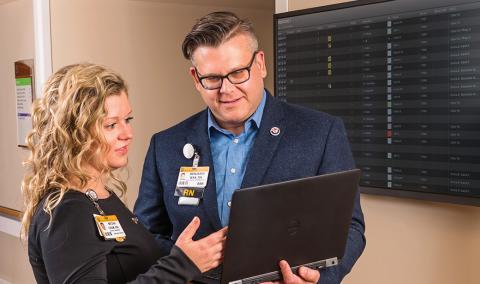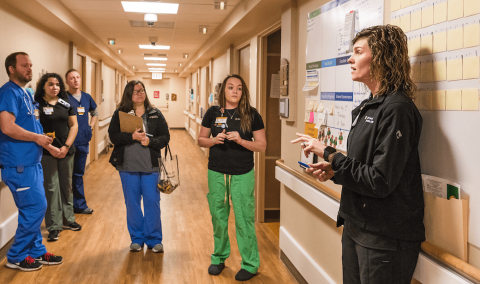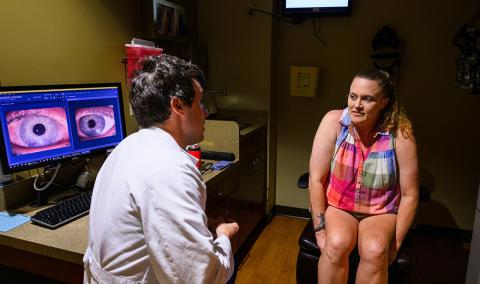At MU Health Care, we take our mission to save and improve lives incredibly seriously.
This dedication to our mission goes hand in hand with our commitment to quality. It is this commitment that drives us at MU Health Care to continuously evaluate our performance to ensure our patients receive the best care.
Quality improvement and innovation are part of MU Health Care’s DNA. Our dedication to quality involves a continuous cycle of setting high goals, measuring our performance and making improvements. This cycle is dynamic and will never end – nor should it.
In the past three years, more than 1,600 quality improvement projects have taken place across our academic health system and involve every employee, from physicians and nurses to housekeepers, facilities engineers and food service workers.
In cooperation with the Tiger Institute for Health Care Innovation at MU, we have implemented one of the most advanced electronic medical records in the country. The electronic medical record uses sophisticated algorithms to analyze patient data and automatically flag when patients may be at increased risk for acquiring sepsis or for being readmitted to the hospital. This extra layer of attention helps our care team ensure our patients get excellent care by detecting potential issues before they happen.
This sophistication is especially important because MU Health Care cares for the most desperately ill and injured patients in mid-Missouri. People from across the state are transferred to MU Health Care because of its status as a tertiary referral center and Level 1 trauma center. These patients from other hospitals often arrive with multiple chronic conditions and complex health care needs.
We take seriously our responsibility to provide high-quality care to all our patients and to share our progress on quality initiatives. That’s why we have been reporting meaningful quality data to the public through the Centers for Medicare and Medicaid Services for more than 10 years.
Periodically, CMS adjusts the way it calculates hospital acquired conditions, an important metric in its assessment of hospital quality and safety. Previously, patients transferred to MU Health Care from other hospitals were excluded from key hospital acquired conditions calculations. However, with CMS’ recent adjustments, more of these patients are now included.
This change in calculations has negatively affected MU Health Care’s ratings, and our Medicare payments will be reduced in federal fiscal year 2019 through CMS’ hospital acquired conditions program. This reduction, equal to 1 percent of Medicare payments, is based on data collected in 2014 through 2017 that placed MU Health Care in the bottom quartile in key areas that are heavily weighted in CMS’ assessment.
CMS also has adjusted the overall hospital rating of MU Health Care to one out of five stars, based on performance from 2014 through early 2018. This rating does not fully reflect the progress MU Health Care has made in a number of key areas critical to patient care, including marked improvements – according to CMS data from 2017 through 2018 – in patient experience, effectiveness of care and timeliness of care.
We are certainly disappointed about the most recent scores released from CMS; however, we closely monitor our performance on an ongoing basis and make the necessary modifications and changes in processes and procedures.
For example, we have implemented specific efforts to address many of the measures where we were underperforming and have already made marked progress in the following areas: safety of care (including hospital acquired conditions), readmissions and mortality.
Since obtaining data that are more detailed from CMS in January 2019, we have increased focus on quality and safety initiatives in the areas of highest impact to patients and further mobilized leadership across the organization to address performance improvement.
We have established dedicated performance improvement teams in key areas, chartered and assigned senior leaders and medical directors, and defined priority clinical and quality measures. These teams have aggressive goals and are presenting progress reports to the newly chartered Quality and Patient Safety Committee, chaired by our executive leadership.
The positive results we are seeing will not be published for one to two years due to a lag in time between the submission of data and the follow-up review by CMS. Even as we enhance processes to improve future ratings, MU Health Care continues to immediately investigate every incident that impacts the quality and safety of care.
On an ongoing basis, our medical staff, patient care staff and hospital leadership work collaboratively to identify and pursue new ways to provide our patients with the quality care they deserve and expect from MU Health Care. While we take seriously CMS ratings and appreciate the opportunity to reflect on new ways to improve, we are continually striving for excellence – driven by our mission to save and improve lives.
Published February 11, 2019



























